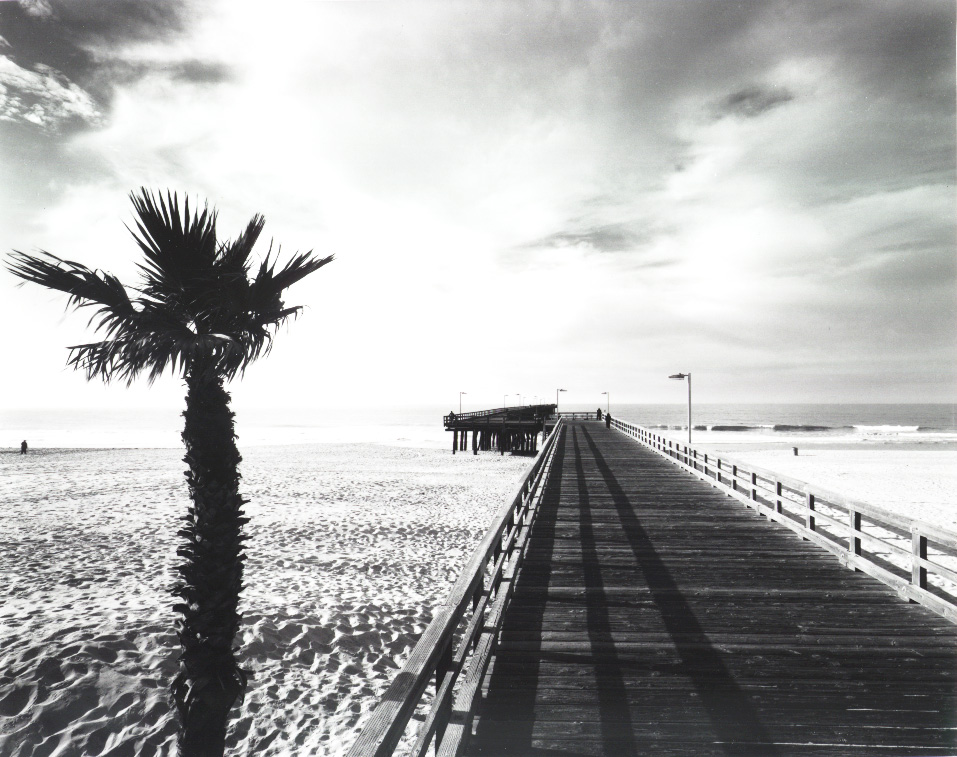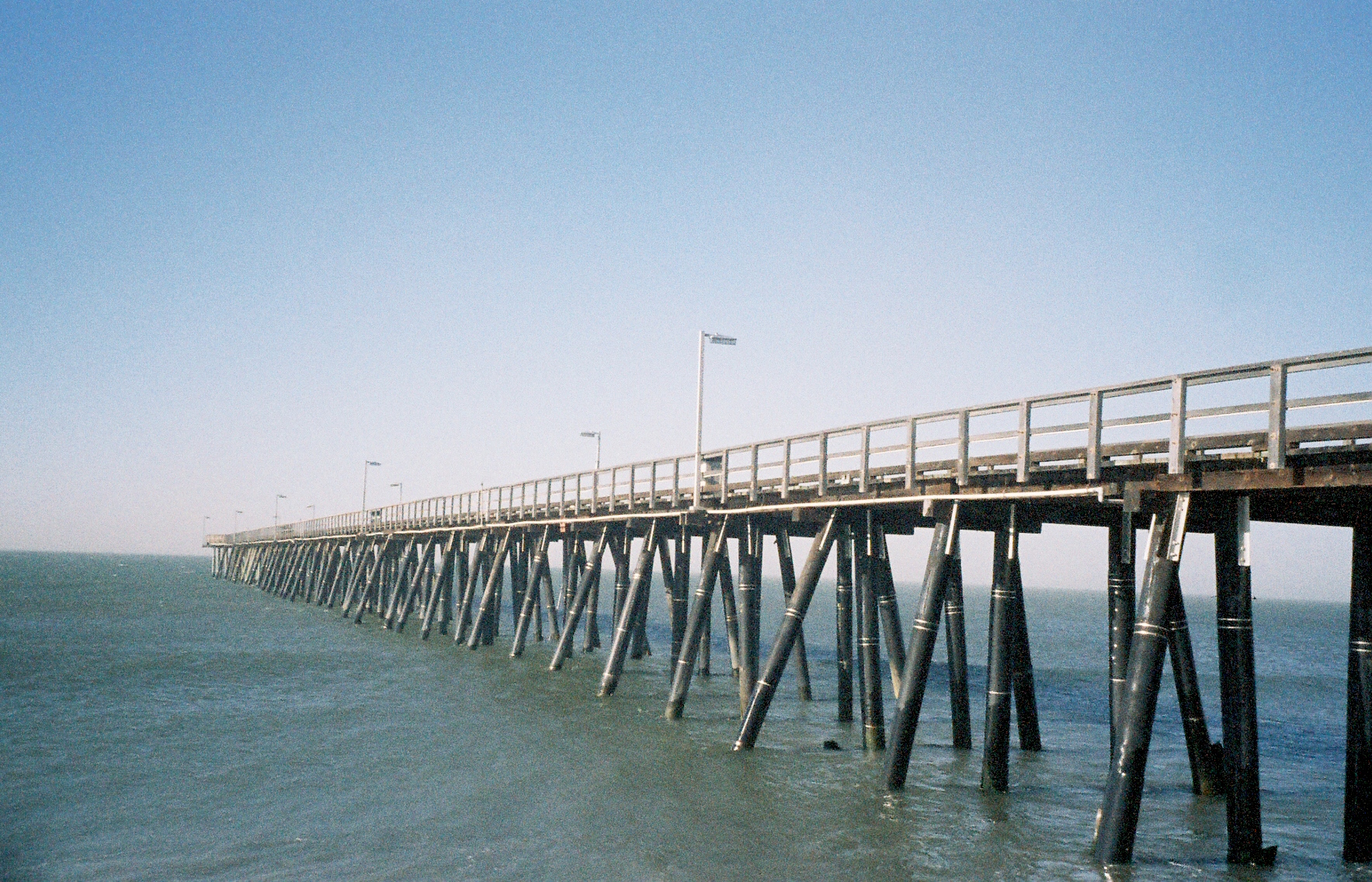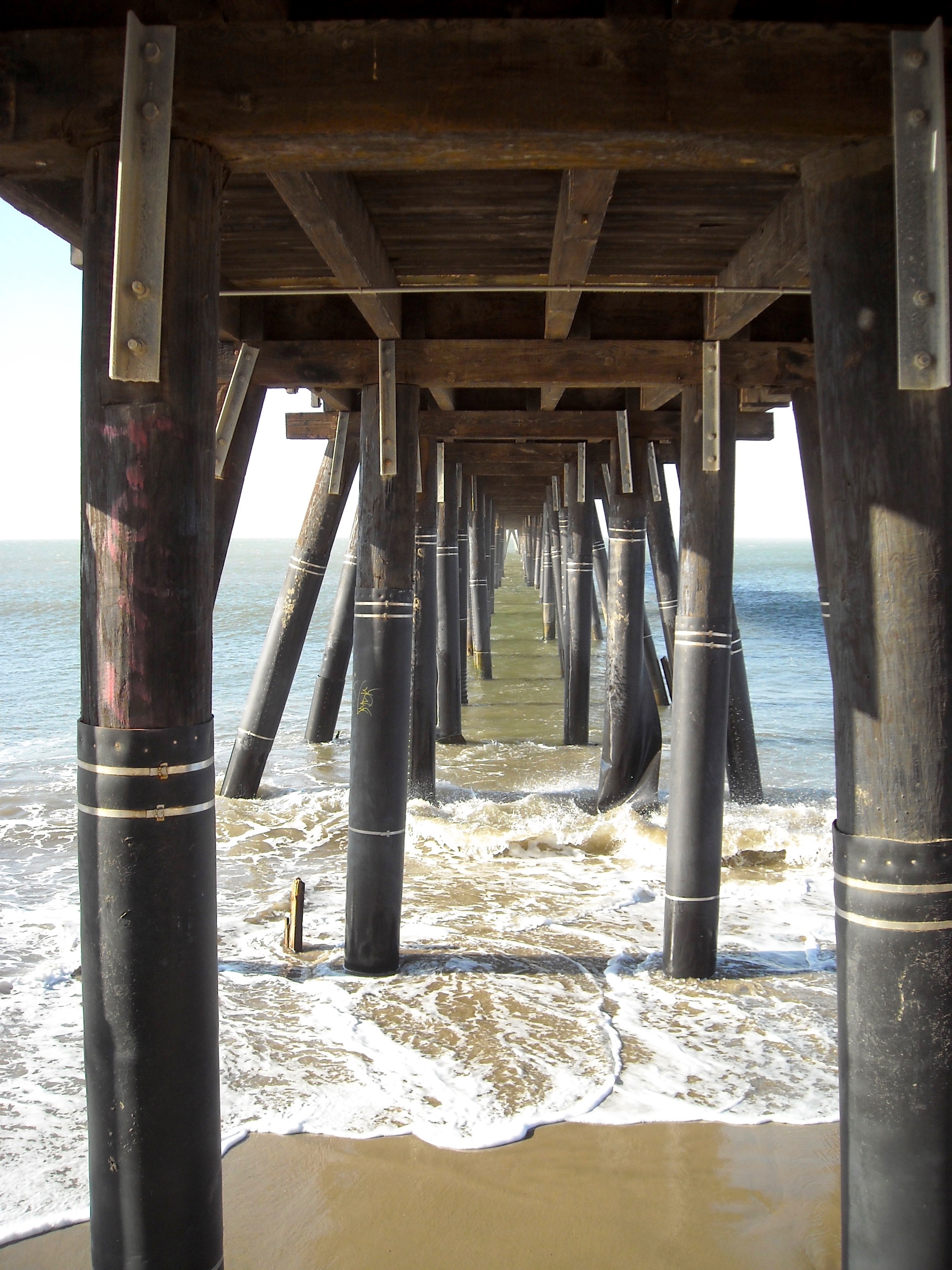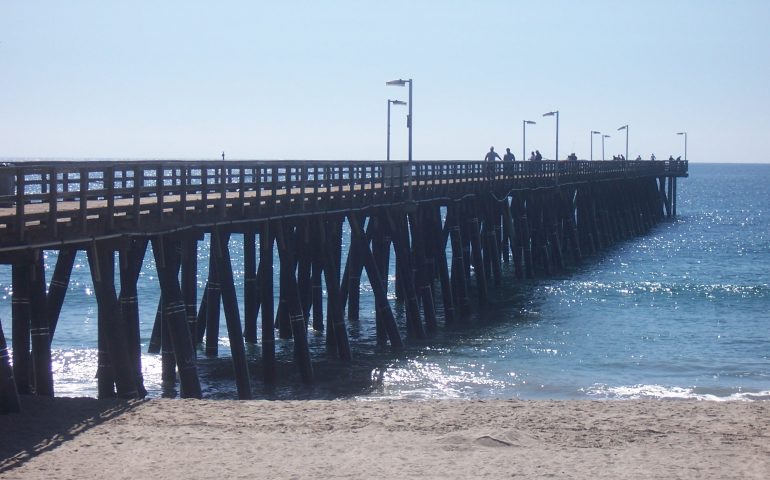Louis Leisman of Oxnard caught a record fish at Hueneme Sunday while fishing off Hueneme wharf. It was a white sea bass and weighed 26 pounds. Leisman does not use a line. He speared the fish. —Oxnard Daily Courier, September 29, 1925
Plenty of smelt, is the report of fishermen on the Hueneme wharf. There is also a run of small bonita from the pier which is unusual for so close in. —Oxnard Press-Courier, September 22, 1926
Kelp bass are biting now exceptionally well, according to Leo Doerner. The best hours for fishing are between 7 and 10 o’clock in the morning. Fishing is done from the Hueneme wharf for these fish. —Oxnard Press-Courier, May 5, 1927
100 Watch Landing of 400-Pound Jewfish Off Hueneme Wharf by Hollywood Fisherman
The biggest fish story of the weekend comes from Hueneme where the five weeks old patience of a Hollywood angler was rewarded with the capture of a 400 pound jewfish yesterday. A crowd of over 100 assembled on the Hueneme wharf to watch the landing of the monster fish, which took an hour and half of struggle.
The successful fisherman was Arthur Kovalovsky of 7300 Sunset Boulevard, Hollywood, who has camped at the Hueneme Beach resort for most of the past 5 weekends, spending most of the time trying to tempt the big fish to accept his offering of three pound mackerel used as bait. Mr. Kolvalovsky, according to Henry Horsewood of Hueneme, who reported the catch, has a special outfit which he values at about $200, designed for big fish. Until yesterday he was unsuccessful in landing any of the large fellows though some were caught at times.
The big jewfish, which onlookers estimated to be a six footer, put up a game fight and took almost the full length of line, which seemed “several miles long.” He finally landed him after an hour and a half with the aid of four pound gaffs. The lucky fisherman was generous and distributed fine steaks to many of those present. Mr. Horsewood reported his share as excellent eating. Hueneme had a record day yesterday, the crowds fully equaling in number those of the Fourth of July. —Oxnard Daily Courier, July 25, 1927

Potpourri — Perhaps more than you want to know about the Hueneme Pier
<*}}}}}}}}}>< — Fish surveys conducted by the California Department of Fish and Game from 2004-2009 showed 19 species of fish in the following numerical order — Pacific sardine, jacksmelt, Pacific mackerel, walleye surfperch, barred surfperch, jack mackerel, topsmelt, staghorn sculpin, queenfish, shiner perch, Pacific bonito, silver surfperch, California corbina, yellowfin croaker, white croaker, pileperch, speckled sanddab, grass rockfish and thornback ray.
<*}}}}}}}}}>< — Everyone seems to know that the prime time to catch halibut is the late spring to mid-summer months. But maybe someone forgot to tell the halibut. Super Bowl Sunday, January ’00, saw several of the regulars out at the mostly deserted pier. Since it was a special day, they had brought buckets of live anchovies for bait. They caught some halibut, some more halibut, and then some more halibut. When they finished, they had 11 keeper-size halibut including an impressive 30-pounder (and had released many more under-sized flatties). It isn’t supposed to be like that in January! Right?
<*}}}}}}}}}>< — The pier opened in 1968 and it didn’t take much time to attract a regular following of anglers.
WHEN THE FOG hovers over the end of the Port Hueneme fishing pier, there is a strange, almost eerie feeling of aloneness for anyone who ventures out across the wet planking to the pier’s west end. Summer activities on the beach are several hours away. The only sounds you hear are those of waves, the foghorn and the occasional clack clack of a fisherman’s cart being pulled across the planking toward the end of the pier. As the fog closes in behind you and your vision is restricted to a few feet in any direction, you wonder how secure the. Platform is and just how far below are the waves you hear moving against the pilings.
Occasionally you pass a lone fisherman who appears out of the fog and turns from his fishing pole to say good morning. It’s an eager greeting for both parties. Perhaps the fisherman was also feeling a bit alone. He disappears as quickly and the end of the pier becomes barely visible as a gray shadow a few yards ahead.
CLUSTERED at the end of the pier is a group of hearty fisherman who have come with the first morning light to try their luck in the waters: below. They are young and old, experienced and novice, tourists and old-timer. They have one thing in common, enthusiasm about fishing.
Many of the early morning pier fishermen come every day at dawn and leave when the fair weather fishermen start arriving before noon. Jon Freiberg, 84, from Ventura, is called “Grandpa” by many of the other regulars. When asked how long he has been fishing he says, with a strong accent, “I yus started”, and then, as if it were a silly question, “Oh, I been fishing all my life.” Mrs. Lynn Baldwin of Port Hueneme, says she likes the quiet of the early morning. “I’m on vacation,” she says. “I work in a laundry and it’s pretty noisy there. It feels good to relax and enjoy the quiet.”
DOWN THE PIER a few feet, and barely visible, are a group of boys trying their luck with something less than the best equipment. One of the boys, Steve Sciacca, of Oxnard, gives up his pole for a warm blanket and a little rest on one of the benches nearby.
To “Grandpa” and the others, catching fish is “not all that’s important. They shrug off a comment about the red tide and the brown water. “Grandpa” Freiberg, says, sort of under his breath, “you can still-catch ’em in that.” The early-morning meeting at the end of the Port Hueneme fishing pier; foggy or clear, good fishing-or-bad, is a time to be alone” with the fog, salt air, and your fishing gear.
—Ted Nauman, PC, The Weekly Magazine of Ventura County, August 1, 1971
<*}}}}}}}}}>< — My absolute worst trip to the pier took place in October of 2008 during a time of strong, strong SoCal winds. I had the pier to myself and soon found out why when I could barely keep the rigging from my light pole in the water. One ounce of weight wasn’t going to hold bottom and even the heavier rod with a heavier sinker was shaking so much that it made fishing near impossible. In addition, many of the pilings were new and devoid of any fish attracting mussels. I tried the end, I tried mid-pier, and I tried inshore. I tried under the pier and away from the pier—all with not the slightest response. Not even a nibble (although I’m not sure that I could have detected a nibble). When the wind gods cranked up the velocity to an even greater pitch, and increased their efforts to take away my hat, I decided to leave. It was a great picture-taking day if you wanted to see the offshore islands but it certainly was not a day to catch a fish. While that day’s winds were unusual, the pier does have a reputation for wind. For whatever geographic reason, the pier can often be windy while the piers not too far away at Ventura and Santa Barbara are calm.

An empty pier
<*}}}}}}}}}>< — Interesting studies were done in conjunction with plans for the “Hueneme Outfall Replacement Project.” The outfall, designed to be located offshore between the Port of Port Hueneme and the pier, would see up to 19.1 million gallons of effluent released per day into the area’s seawater. Three studies of the area’s fish were cited: (1) Kolpack and Straughan (1972) concluded that in water depths of from 20 to 100 feet, speckled sanddab (Citharichthys stigmaeus) and the curlfin sole (Pleuronichthys decurrens) were most common species. (2) The City of Oxnard in 1980 said the nearshore bottom fish were primarily flatfish (speckled sanddab, hornyhead turbot [P. verticalis], and California tonguefish [Symphurus atricauda]). (3) An Aquatic Bioassay & Consulting report in 2005 based upon samples from locations at and south of the Oxnard Wastewater Treatment Plant discharge said the fish were dominated by speckled and Pacific sanddabs (C. stigmaeus and C. sordidus) and English sole (Parophrys vetulus). Other than the two types of sand dabs, I haven’t seen any of the other species caught at the pier.

History Note. The name Hueneme was given to the point in 1856 by James Alden who was in charge of the Coast Survey steamer Active. In 1870 the town was settled and the name was adopted; it apparently is derived from the Chumash Indian village Wene’me or Wene’mu (meaning place of security or resting place).
Although Port Hueneme is not one of California’s more visited tourist areas, it is the major deep-water port between Los Angles and San Francisco, and does receive considerable visitors, as does the pier. Most probably don’t know (or perhaps even care) that a pier was envisioned for Point Hueneme as early as 1867 and that one has existed here since 1871.
In 1867 Thomas Bard (who held the claim to La Colonia, a Spanish land grant for the area) and Captain W.E. Greenwald of the U.S. Geodetic Survey surveyed the sand dunes and shoreline of the area. They learned of an underwater canyon that had been created by the strong freshwater flow out of an aquifer just east of the point. The 30-foot-deep Hueneme Canyon was the result. The current of freshwater was so strong that ships were actually able to take on freshwater while still at sea! The canyon also reduced the size of the surf near the shore and Beard became convinced that it was an ideal site for a wharf. His immediate plans included a wharf from which local produce should be shipped. His long-range plan was a hope that the site could be the terminus for the Atlantic Pacific Railroad. However, it would be four long years before the wharf was built.
In May of 1871 construction began on a wharf under the direction of Bard’s Hueneme Wharf and Lighter Company. By August of that year the Port Hueneme Wharf (sometimes called Bard’s Wharf) was completed. The wharf was a structure 900-foot-long that reached water that was 18-feet deep. It was the first major wharf between Santa Cruz and San Pedro.
It was also the first wharf built by Bard, Salisbury and Frazer, the company that would soon build most of the area’s wharves. Their firm constructed Stearns Wharf in Santa Barbara (for J.P. Stearns), as well as wharfs at Ventura (for Joseph Wolfson), Santa Cruz Island (for the Santa Cruz Island Company), Gaviota (for Col. W.W. Hollister and Thomas Dibblee), Point Purisma (for the Lompoc Valley Land Company) and Santa Monica (for the Los Angeles and Independent Railway).
Unfortunately some of the pilings used at their early wharves were substandard and thus highly susceptible to the normal enemies of wood pilings, creatures like limnoria and torpedo. This would later be the cause of considerable conflict and questions when the pier at Ventura suffered early damage, while the pier of its trading rival at Port Hueneme remained standing.
Although Bard’s Hueneme’s pier had opened first, and seemed to avoid the construction problems found at rival wharves, it was soon evident that even deeper water was needed for some of the larger ships. Soon after the wharf was lengthened to 1,426 feet where the water was twenty-two-feet-deep. The wharf quickly became a regular stop for ships like the Kalorama, Alcatraz, Coos Bay and Bonito.
By 1887 Hueneme and its wharf had become an important locale for trade. During the harvest season, the two warehouses out on the 40-foot-wide end of the wharf would be loaded with crops bound for larger cities and the coastal schooners would be kept busy plying California’s water highway. During the fiscal year ending March 31, 1888, 236 ships visited the wharf—169 steamers, 23 schooners and 44 steam schooners. For a time, the wharf was the leading shipping point between San Pedro and San Francisco.
By 1895 the wharf had apparently been lengthened to 1500-feet to accommodate even larger ships. However, in 1898 the railroad reached the area and chose to locate in Oxnard. The result was less trade for the wharf, a decrease in activity at Hueneme, and a shift in development (and growth) to nearby Oxnard.
Hueneme Boom Is Booming
Things are doing at Hueneme. Geo. E. Hart, real estate promoter, has taken possession of the old wharf office and will completely overhaul and renovate the same, after which it will be used as a real estate office in addition to the original one. A skating rink, with a maple floor, 60×110 feet, will grace the east warehouse. It is rumored that a hotel will be built—sometime—perhaps—but not this year at any rate. The Hueneme Wharf Company will henceforth be known simply as the Wharf Company. Plans and specifications have been submitted for a pleasure pier, which it is alleged, will be built in the near future. —The Oxnard Courier, July 13, 1906

Having lived in Port Hueneme for over 20 years and having been a pier rat nearly the whole time I will say that this pier is one of the worst piers in southern CA when it comes to the fishing. Everything from the dumping of dredge spoils directly upcurrent from the pier every 2 years to the excessive winds and frequent high surf and rip currents seem to conspire against having a successful fishing trip here, even the White Croaker disappeared years ago so its basically a “catch nothing at all” pier on a majority of days. It can be a good pier for Mackerel and Sardines when the schools show up, the crabbing can also be good here from about Feb. to May , and its also a good pier for big Bat Rays, but basically don’t get your hopes up when visiting this pier. The lack of fish pretty much keeps the crowds away though and on more days than not I’ve been the only guy fishing out there, so there is at least one positive about the place I suppose.
Does anyone know what year the Port Hueneme Beach was closed and why?
For those above about fishing, try a Sabiki jig with a one-ounce weight, and get the smallest hooks you can find, you can buy them online or @ walmart!